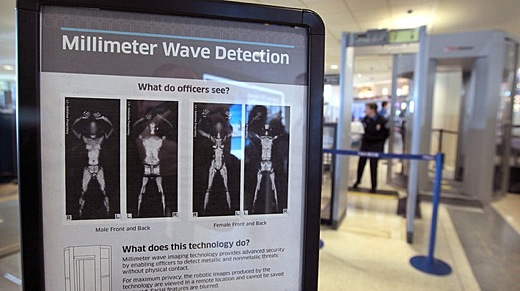SUBHEAD: TSA is abandoning expensive body scanners x-ray technology after law suit on privacy invasion.
By Lizzy Duffy on 19 January 2013 for NPR News -
(http://www.npr.org/blogs/thetwo-way/2013/01/18/169733300/invasive-body-scanners-will-be-removed-from-airports)

Image above: Information presented by TSA as to what its agents should see of your private parts. From original article.
The Transportation Security Administration will remove controversial body scanners from airport security after OSI Systems Inc. didn't update its machines' software to make scanned images of airline passengers less revealing.
"It became clear to TSA they would be unable to meet our timeline," Karen Shelton Waters the agency's assistant administrator for acquisitions told Bloomberg News. "As a result of that, we terminated the contract for the convenience of the government."
Privacy advocates have said that the images are offensive, particularly when children and the elderly are scanned.
"TSA will end a $5 million contract with OSI's Rapiscan unit for the software," Jeff Plungis reports for Bloomberg, "after Administrator John Pistole concluded the company couldn't meet a congressional deadline to produce generic passenger images."
Last year, 76 Rapiscan scanners were removed from the busiest U.S. airports. As Pro Publica reported, the TSA's main concern was that the scanners slowed down security checkpoints. The remaining 174 machines will be taken out of airports gradually.
Body scanners from another manufacturer, L-3 Communications Holdings Inc., which met the TSA's requirements, are now expected to be used in more airports.
L-3 scanning machines use millimeter-wave technology — radio frequencies that find metallic and non-metallic items — while Rapiscan uses "backscatter" technology that relies on X-ray radiation.
Scanners that used X-rays spread to more airports after Christmas Day of 2009, when Umar Farouk Abdulmutallab's failed attempt to blow up a Northwest Airlines flight with explosives in his underwear.
But in July of 2010, the Electronic Privacy Information Center sued the TSA, saying that the scanners violated privacy laws and that the imagery was equivalent to a "physically invasive strip search."
As Pro Publica reports, X-ray scanners worth about $14 million are now sitting in a warehouse in Texas.
See also:
Ea O Ka Aina: Porno Scanner X-Ray Danger 11/22/10

Image above: Mashup of X-Ray porn with assist by Juan Wilson.
.
By Lizzy Duffy on 19 January 2013 for NPR News -
(http://www.npr.org/blogs/thetwo-way/2013/01/18/169733300/invasive-body-scanners-will-be-removed-from-airports)

Image above: Information presented by TSA as to what its agents should see of your private parts. From original article.
The Transportation Security Administration will remove controversial body scanners from airport security after OSI Systems Inc. didn't update its machines' software to make scanned images of airline passengers less revealing.
"It became clear to TSA they would be unable to meet our timeline," Karen Shelton Waters the agency's assistant administrator for acquisitions told Bloomberg News. "As a result of that, we terminated the contract for the convenience of the government."
Privacy advocates have said that the images are offensive, particularly when children and the elderly are scanned.
"TSA will end a $5 million contract with OSI's Rapiscan unit for the software," Jeff Plungis reports for Bloomberg, "after Administrator John Pistole concluded the company couldn't meet a congressional deadline to produce generic passenger images."
Last year, 76 Rapiscan scanners were removed from the busiest U.S. airports. As Pro Publica reported, the TSA's main concern was that the scanners slowed down security checkpoints. The remaining 174 machines will be taken out of airports gradually.
Body scanners from another manufacturer, L-3 Communications Holdings Inc., which met the TSA's requirements, are now expected to be used in more airports.
L-3 scanning machines use millimeter-wave technology — radio frequencies that find metallic and non-metallic items — while Rapiscan uses "backscatter" technology that relies on X-ray radiation.
Scanners that used X-rays spread to more airports after Christmas Day of 2009, when Umar Farouk Abdulmutallab's failed attempt to blow up a Northwest Airlines flight with explosives in his underwear.
But in July of 2010, the Electronic Privacy Information Center sued the TSA, saying that the scanners violated privacy laws and that the imagery was equivalent to a "physically invasive strip search."
As Pro Publica reports, X-ray scanners worth about $14 million are now sitting in a warehouse in Texas.
See also:
Ea O Ka Aina: Porno Scanner X-Ray Danger 11/22/10

Image above: Mashup of X-Ray porn with assist by Juan Wilson.
.
1 comment :
The Transportation Security Administration will remove controversial body scanners from airport security after OSI Systems Inc. didn't update its machines' software to make scanned images of airline passengers less revealing.Gatwick Parking
Post a Comment